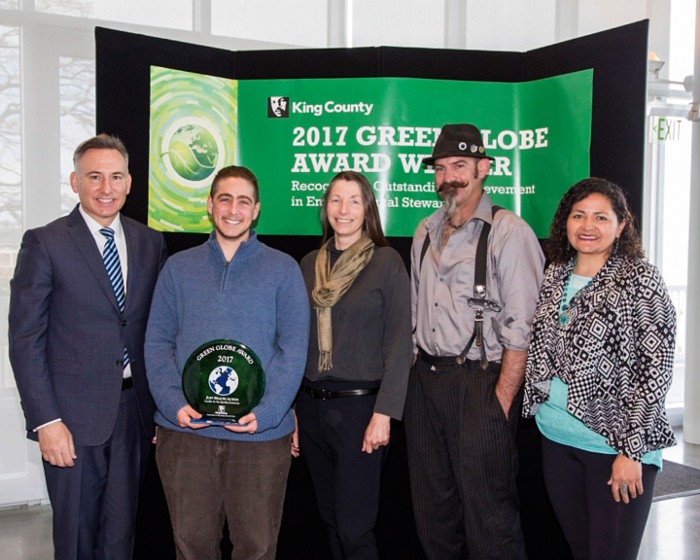
Left to right, King County Executive Dow Constantine, Andrew Schiffer, Linn Gould, Ethan Newstrum, and Paulina Lopez
On Monday, April 17, Just Health Action (JHA) received a Green Globe Award for leading a broad partnership to address the most pressing environmental issue in Georgetown – air pollution. Engaging the community on air quality solutions, they helped implement the community’s choice of a green wall. The result is the largest freestanding green wall in the Seattle area – a 126-foot long, 13-foot high vegetated trellis at CDL Recycle which helps stop the dust from the industrial area from blowing into nearby homes. As a result, awareness is growing of this green solution for air quality.
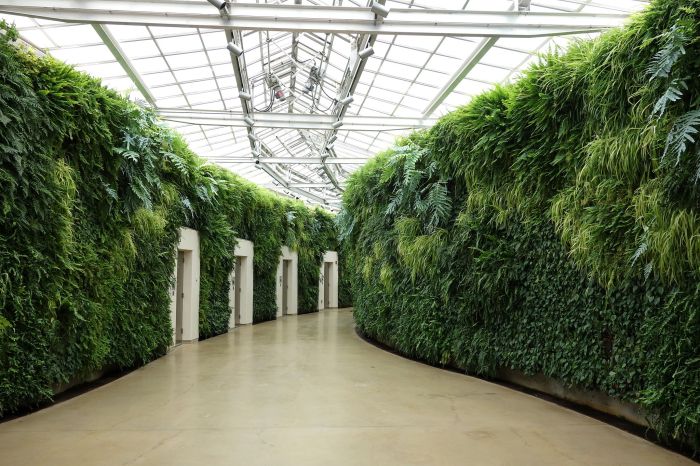
Green wall in Longwood Gardens, Pennsylvania
Green walls come in a variety of forms. They aren’t just a pretty green face in a man-made environment: in addition to cleaning air, they can buffer sound, reduce temperatures that can cause “heat islands”, and, where permitting allows, filter grey water from the buildings. Green walls can provide a soothing natural oasis for urban dwellers and increasingly displaced wildlife like butterflies and bees. They can be built where tree buffers won’t work for space and safety reasons.
When the Georgetown green wall fills in to maximum lushness, it will become a living, breathing member of the community, filtering dust from industrial activities to help protect the eyes and lungs of nearby residents. Another wall will rise up in nearby South Park.
This milestone on a pathway to health is hard-won for the individuals and community groups that led the effort. Residents living near the industrial corridor reported that dust from one source in particular, CDL Recycle, was coating the inside of their homes and getting in their eyes and lungs.
While CDL was working to control dust and permit a new building to contain dusty activities, it wasn’t enough. The dust was adding to an existing problem in Georgetown. “I have dust buildup in my home every day,” says Andrew Schiffer, a neighbor who later became the project coordinator. “I dust the house and the next day it would be back.” Schiffer is echoing a concern voiced by many neighbors, including Kelly Welker, who first raised a flag about the problem.
 Community activism spread beyond individuals to groups and agencies. As part of DRCC’s Clean Air project to address the communities’ concerns about the air pollution issues in Georgetown and South Park, Just Health Action researched solutions across the country and presented three options to the community: green walls, tree planting, and strategic coordination of upcoming “greening” projects.
Community activism spread beyond individuals to groups and agencies. As part of DRCC’s Clean Air project to address the communities’ concerns about the air pollution issues in Georgetown and South Park, Just Health Action researched solutions across the country and presented three options to the community: green walls, tree planting, and strategic coordination of upcoming “greening” projects.
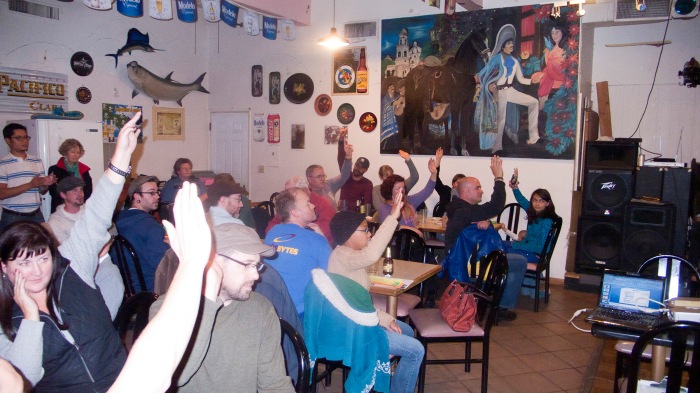 “The community chose the green wall concept,” says Linn Gould of JHA. “Green walls seemed like a unique approach. The community then picked CDL Recycle as the best location for a green wall to help control dust, and CDL agreed to collaborate on the project.”
“The community chose the green wall concept,” says Linn Gould of JHA. “Green walls seemed like a unique approach. The community then picked CDL Recycle as the best location for a green wall to help control dust, and CDL agreed to collaborate on the project.”
The wall’s location and size determines how effective it is controlling dust. CDL chose the first location, replacing an existing fence in disrepair on the eastern edge of the property. But an installation at that location would have improved aesthetics without addressing the problem. “The wind blows dust over the concrete barrier on the northwestern corner of the property,” says Schiffer. “We needed to catch dust where the wind was blowing it off the site.” Moving the wall and extending it increased project cost.
Permitting a freestanding green wall presented the next hurdle. The wall is located by a railroad track and busy arterial, where safety is a concern for the City of Seattle. The wall design would need to be solid enough to stay upright in high winds and other natural conditions. Project organizers struggled through three rounds of permitting as the size of the concrete footings that anchor the wall grew larger- and more expensive- each round.
Partnerships helped the community clear these hurdles. Duwamish River Cleanup Coalition Technical Advisory Group (DRCC/TAG) put in staff time, provided input on community engagement, and contributed about $25,000 from an EPA Environmental Justice Grant. King County Wastewater Treatment Division (WTD) provided $70,000 through a Green Grant for outreach, materials, and construction. WTD also supported plants at the South Treatment Plant in Renton with space, recycled water, and biosolids compost. CDL Recycle contributed labor and heavy equipment that JHA Director Linn Gould says was worth about $30,000 in matching funds, and “critical to success.” The Duwamish Valley Youth Corps and DIRT Corps were trained and provided labor which builds job skills and resumes. Local companies donated materials.
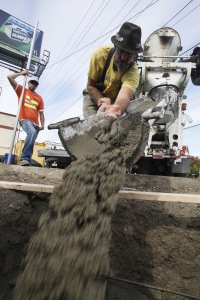 Individual contributions were essential to success. Ethan Newstrum, a former Georgetown resident and union carpenter with extensive experience in concrete work, was hired onto the project to oversee layout and construction. Ethan also taught job trainees with DIRT Corps how to build the green wall. “I usually work on my own projects when I’m taking time out between jobs,” says Ethan. “But this time, I decided to help my community.”
Individual contributions were essential to success. Ethan Newstrum, a former Georgetown resident and union carpenter with extensive experience in concrete work, was hired onto the project to oversee layout and construction. Ethan also taught job trainees with DIRT Corps how to build the green wall. “I usually work on my own projects when I’m taking time out between jobs,” says Ethan. “But this time, I decided to help my community.”
Ethan provided critical input to the engineering design and labor and oversight to construction. Andrew Schiffer says, “I relied on Ethan for so much of his expertise. I don’t know what we would have done without him.”
A planting event on Make a Difference Day in October 2016 marked the beginning of life at the Georgetown green wall. DRCC’s Hannah Kett took the lead bringing together teams of volunteers.
What’s next? The community is working on another green wall in nearby South Park, also in need of air quality improvements. As part of the Green Grant, King County is working with the Duwamish Valley Youth Corps create signage for the Georgetown green wall, giving a voice to their issues and values.
This special installation will receive routine maintenance, and monitoring to evaluate how it is working. In spring of 2017, an irrigation system will be installed. Over the next 3 years, the plants will be maintained by DIRT Corps and DVYC. Soil health will be monitored to ensure healthy plant growth. As part of DRCC’s Clean Air partnership, Western Washington University will monitor air pollution captured by leaves on the green wall. What the community learns from the Green Wall will help to inform other projects in similar areas.
 Next year, vines will begin covering the mesh on Georgetown’s green wall. Eventually, fragrant flowers will tempt you to breathe in deeply as the leaves clean the air. You will be able stand at 7201 East Marginal Way in Seattle, take in the beauty and fragrance, and then turn around and imagine the busy industrial corridor lined with greenery. This green wall now stands as a testament to community vision, partnerships, and the work of many hands: a way finder on a path to healthier neighborhoods for everyone.
Next year, vines will begin covering the mesh on Georgetown’s green wall. Eventually, fragrant flowers will tempt you to breathe in deeply as the leaves clean the air. You will be able stand at 7201 East Marginal Way in Seattle, take in the beauty and fragrance, and then turn around and imagine the busy industrial corridor lined with greenery. This green wall now stands as a testament to community vision, partnerships, and the work of many hands: a way finder on a path to healthier neighborhoods for everyone.
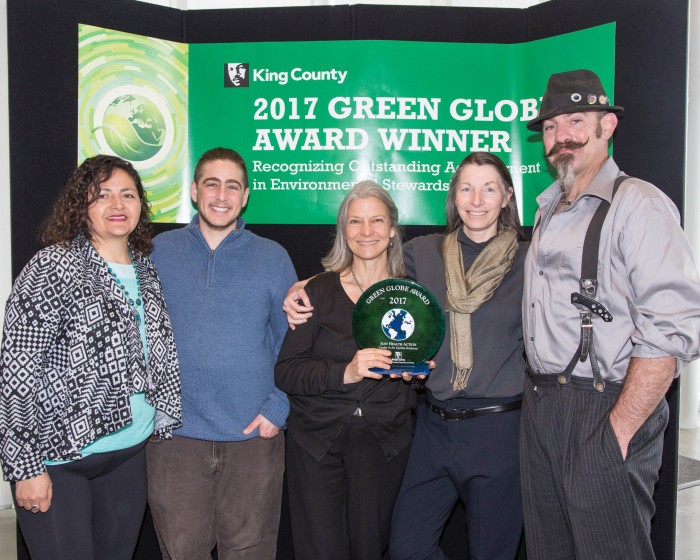
King County project lead joins the partners to celebrate the Green Globe Award
Thanks to Just Health Action for providing site and community photos.










